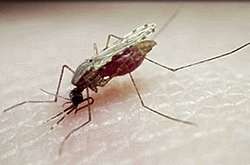Bug-Zapper: A Dose of Radiation May Help Knock Out Malaria

How are physicists helping an effort to eradicate malaria, the mosquito-borne disease that kills more than one million people every year? Researchers at the National Institute of Standards and Technology used their expertise in radiation science to help a young company create weakened, harmless versions of the malaria-causing parasite. These parasites, in turn, are being used to create a new type of vaccine that shows promise of being more effective than current malaria vaccines.
The new vaccine is a departure from previous approaches, which have usually depended on proteins derived from only part of the parasite Plasmodium falciparum, the most dangerous species of parasite that causes malaria.
Using vaccines based on whole living parasites had been on scientists’ minds for several decades, after they discovered that volunteers built up high levels of protection to malaria after being exposed to mosquitoes containing live, radiation-weakened parasites. But manufacturing technology only recently has been developed to the point where it is possible to efficiently extract weakened parasites from their mosquito carriers in order to make a vaccine.
With their knowledge of measuring radiation doses for industrial processes such as medical equipment sterilization, NIST researchers have been lending their expertise for several years to Maryland-based biotech firm Sanaria Inc., which is creating the new vaccine. In the manufacturing process, live mosquitoes containing the parasite are exposed to gamma rays. To ensure that the parasites are sufficiently weakened for the vaccine, yet remain alive, they must be exposed to a radiation dose of at least 150 gray, but not much more. Coincidentally, this is also the dose used to delay sprouting in potatoes and onions.
One critical design issue is ensuring a relatively uniform radiation dose regardless of where the mosquito is in the chamber. Using radiation-sensitive test materials inside the chamber as well as sophisticated measuring equipment, NIST researchers mapped out the radiation dose at different parts of the chamber.
They initially found there was a variation in dose within the chamber, but by suggesting that the manufacturer change the position of the chamber relative to the radiation source they were able to significantly reduce this variation in dose. This not only increases the speed of the process, but more importantly improves the quality of the process. To be safe for human trials all mosquitoes in the chamber must get their minimum dose of 150 gray.
The vaccine is currently being manufactured for the anticipated human clinical trials. NIST researchers will continue to be active in the manufacturing process by doing regularly scheduled quality-assurance tests that ensure the desired dose is being delivered to the mosquitoes.
Source: NIST




















